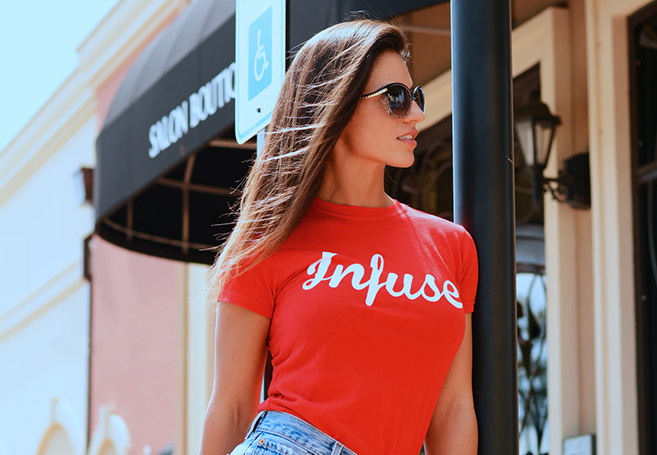It’s a staple of everyone’s wardrobe, and possibly the most common item of clothing. Whether we’re relaxing at home or out on the town with friends, we turn to the good old-fashioned t-shirt to help us look the part. But finding the best t-shirt for your style can be tricky. Shops are full of different types, from baggy garments designed to give maximum comfort, to skin-tight varieties that show off your figure. The problem is making sure we don’t pick the wrong one. Here are some things to consider on the holy grail for the perfect t-shirt.
Find the perfect fit
T-shirts come in many styles, but the key to finding one to fit you is to assess your upper body. Balance is the key. If you’re proud of your torso, then great: find one that showcases your attributes without feeling tight. If not, then go for a classic fit – this will strike the right balance between oversizing and clinging to your body. Sleeves should always finish mid-bicep. Any further down is too long, and higher up runs the risk of it turning into a vest. Also, the shoulder seams should always match up with where the curve of your shoulder ends. Finally, the t-shirt should finish at the top of your hips. It should never cover your butt and equally should always conceal your stomach if you lift your arms up. These are simple steps to follow but will make a big difference to how you look!
Fabric is important
A lot of people fall into the trap of thinking the heavier the t-shirt material, the better the quality. This isn’t true. Consider cotton: this is a lightweight yet strong material that allows your body to breathe, and it’s the best t-shirt material for all kinds of weather. Failing that, then a 50/50 cotton and polyester blend is a fine alternative – it’s often cheaper and less likely to shrink in the wash, although it can collect fuzz and make you sweat a little more. Some manufacturers use fabrics like tencel or viscose, but these can be pricey and not as t-shirt friendly as cotton. If forced to choose, then cotton wins every time. It has universal appeal due to its high quality and soft feel. A winner for all situations.
Neutral colours are still in…
T-shirts work best when complementing the rest of your outfit, and this is why neutral colours win time and time again. White tees, for example, work with pretty much anything – whether under a shirt, or with a pair of jeans. The James Dean look still hasn’t gone out of fashion after all these years. Black and navy t-shirts, meanwhile, can add a certain smartness to your look that others don’t. Pairing them with denim provides the ultimate smart-casual look that is necessary for many social occasions. Grey is a hugely popular neutral colour: it comes in many different shades and, like white, complements a shirt very well. One thing to note, however, is lighter shades tend to show up sweat easily, so opt for darker tones if you’re prone to perspiration.
…But feel free to add a splash of colour
Keeping things neutral, though, can be a little dull. Injecting a bit of colour can energise your look. With t-shirts, a lot of it is down to skin tone. Experts recommend that pale guys adopt darker colours which contrast with their complexion, so tones such as a soft maroon, instead of the bright red you might find on a roulette wheel, are the way to go. On the other hand, those with dark or olive skin should go for something colourful. Bright and bold colours are the order of the day here, and there is a wide spectrum to choose from. There are many great colour guides to check out online that can help you arrive at a decision for your next t shirt purchase.
Neck type
It’s one of the classic t-shirt dilemmas: to go with the V-shaped neck or not. Well, it mainly depends on your height and neck size. A V makes your neck look longer, so if you’re short and stocky then it’s probably the best choice. It also adds a slimming effect, and offsets round or wide facial shapes. On the other hand, crew necks normally suit taller guys with longer necks: these don’t elongate your neck like a V, and also make your shoulders looks broader. If you do opt for the V, try to avoid the deep Vs, which can show off more than is necessary and make you look like a Jersey Shore cast member.
Price
Of course, we can’t choose the perfect tee without mentioning the price. Like with all items of clothing, what you spend on t-shirt depends on what type of occasion you’ll wear it for and how often you’ll wear it. That said, there is less cost variation with them than, say, a pair of jeans or a jacket. There is a rule of thumb that anything more than 30$/€ is expensive, and some brands are overpriced, however it could be worth paying that bit more for better quality. One thing to avoid is the mass-produced $5 tee that is prone to damage after a few washes, so a happy medium is often the key. There are plenty of mid-range tees that give you the best of both worlds: good quality and an affordable price.
Photo by Calvin Lupiya on Unsplash
.
.


